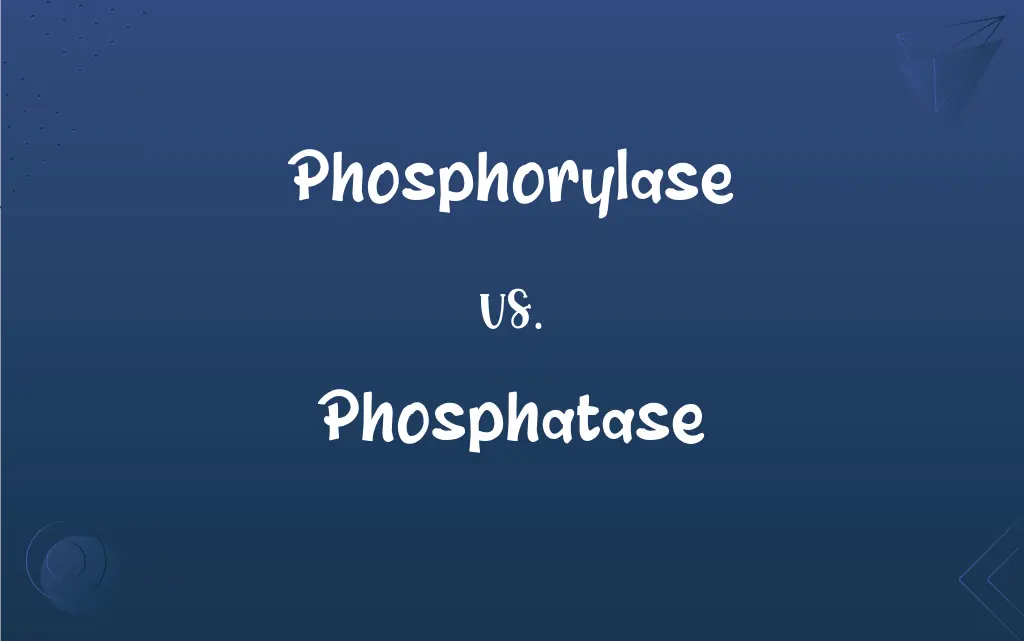Phosphorylase vs. Phosphatase: What's the Difference?
Edited by Harlon Moss || By Janet White || Published on January 19, 2024
Phosphorylase adds phosphate groups to molecules, while phosphatase removes them.

Key Differences
Phosphorylase is an enzyme that adds phosphate groups to substrates, typically using phosphates from ATP, thus playing a key role in energy storage. Conversely, phosphatase is an enzyme that removes phosphate groups from its substrates, acting as a regulator in various biochemical pathways.
Phosphorylase functions mainly in processes like glycogen breakdown, adding phosphates to produce glucose-1-phosphate. Phosphatase, in contrast, might act in dephosphorylating this glucose-1-phosphate, reverting it back to glucose, thus exhibiting opposing functions in metabolism.
In signal transduction, phosphorylase may activate certain pathways by phosphorylating target molecules. On the other hand, phosphatase deactivates or modulates these pathways by removing phosphate groups, serving as a balancing factor in cellular responses.
Phosphorylase is crucial in processes like glycogenolysis, where it facilitates energy release. Phosphatase plays a vital role in cellular homeostasis, ensuring that phosphorylation levels within the cell remain balanced.
Phosphorylase is often regulated by allosteric mechanisms and covalent modification, adapting to the energy needs of the cell. In contrast, phosphatase activity is often tightly regulated through inhibitors or activators, maintaining precise control over dephosphorylation processes.
ADVERTISEMENT
Comparison Chart
Primary Function
Adds phosphate groups to molecules
Removes phosphate groups from molecules
Role in Metabolism
Catalyzes glycogen breakdown
Involved in reversing phosphorylation reactions
Involvement in Signaling
Activates pathways by phosphorylation
Deactivates/modulates pathways by dephosphorylation
Energy Dynamics
Facilitates energy release from storage
Regulates energy usage and storage
Regulatory Mechanisms
Allosteric and covalent modifications
Inhibited or activated by specific molecules
ADVERTISEMENT
Phosphorylase and Phosphatase Definitions
Phosphorylase
Phosphorylase plays a key role in energy metabolism, particularly in glycogenolysis.
During exercise, phosphorylase in muscles breaks down glycogen to fuel the increased energy demand.
Phosphatase
Phosphatase is an enzyme that removes phosphate groups from its substrates.
Alkaline phosphatase in the bloodstream dephosphorylates various molecules for detoxification.
Phosphorylase
Phosphorylase enzymes are regulated by allosteric effectors and hormonal control.
Phosphorylase in the liver is activated during fasting to maintain blood glucose levels.
Phosphatase
Phosphatases play a critical role in cellular signaling by deactivating phosphorylated proteins.
Protein phosphatases deactivate phosphorylated enzymes, turning off signal transduction pathways.
Phosphorylase
Phosphorylase is involved in various biological pathways, including glycogen breakdown and nucleotide synthesis.
Phosphorylase acts in the liver to release glucose into the bloodstream during periods of low blood sugar.
Phosphatase
Phosphatases can be specific to certain substrates or broad in their activity, impacting various biological pathways.
Tyrosine phosphatases specifically remove phosphate from tyrosine residues in proteins.
Phosphorylase
Phosphorylase is an enzyme that catalyzes the addition of a phosphate group to a substrate.
In muscle cells, glycogen phosphorylase adds phosphate to glycogen, producing glucose-1-phosphate for energy.
Phosphatase
Phosphatases are involved in regulating metabolic processes by controlling the phosphorylation state of enzymes.
Lipid phosphatase regulates fat metabolism by modulating the activity of lipid-related enzymes.
Phosphorylase
Phosphorylase can function in both synthetic and degradative pathways, depending on the specific enzyme type.
Glycogen phosphorylase is crucial for breaking down glycogen stores during periods of energy need.
Phosphatase
Phosphatases are crucial in maintaining cellular homeostasis and are often tightly regulated.
Phosphatases in neurons regulate neurotransmitter release by modulating phosphorylation states.
Phosphorylase
Any of a class of enzymes that catalyze the attachment of a phosphate group to another molecule.
Phosphatase
Any of numerous enzymes that catalyze the removal of phosphate groups by hydrolysis of phosphate ester bonds. They act in the opposite manner to kinases and are important in metabolism and cell signaling.
Phosphorylase
(enzyme) Any enzyme that catalyzes the production of glucose phosphate from glycogen and inorganic phosphate
Phosphatase
(enzyme) Any of several enzymes that hydrolyze phosphate esters, and are important in the metabolism of carbohydrates, nucleotides and phospholipids, and in the formation of bone.
Phosphatase
Any of a group of enzymes that act as a catalyst in the hydrolysis of organic phosphates
FAQs
Can phosphorylase act without ATP?
No, it generally requires ATP.
Where is phosphorylase commonly found?
In liver and muscle tissues.
Is phosphatase important in metabolism?
Yes, it regulates metabolic pathways.
What does phosphorylase do?
Adds phosphate groups to molecules.
How does phosphatase function differently from phosphorylase?
Removes phosphate groups, unlike phosphorylase.
Do phosphatases need cofactors?
Some do, like metal ions.
Are phosphatases involved in cell signaling?
Yes, they modulate signaling pathways.
Can phosphatase activity be inhibited?
Yes, by specific inhibitors.
What regulates phosphorylase activity?
Allosteric factors and phosphorylation.
Does phosphorylase have clinical significance?
Yes, in glycogen storage diseases.
Which phosphatase is key in bone metabolism?
Alkaline phosphatase.
Can phosphatase activity indicate disease?
Yes, like in liver dysfunction.
What's a common type of phosphorylase?
Glycogen phosphorylase.
Can phosphorylase be genetically deficient?
Yes, leading to metabolic disorders.
Does phosphorylase affect blood sugar levels?
Yes, by releasing glucose from glycogen.
How are phosphatases classified?
Based on substrate and mechanism.
Are phosphatases targeted by drugs?
Yes, in various therapies.
Are there different types of phosphorylase?
Yes, specific to substrates.
What role do phosphatases have in cancer?
They can regulate tumor suppressors.
Does phosphorylase play a role in exercise?
Yes, in energy release from glycogen.
About Author
Written by
Janet WhiteJanet White has been an esteemed writer and blogger for Difference Wiki. Holding a Master's degree in Science and Medical Journalism from the prestigious Boston University, she has consistently demonstrated her expertise and passion for her field. When she's not immersed in her work, Janet relishes her time exercising, delving into a good book, and cherishing moments with friends and family.
Edited by
Harlon MossHarlon is a seasoned quality moderator and accomplished content writer for Difference Wiki. An alumnus of the prestigious University of California, he earned his degree in Computer Science. Leveraging his academic background, Harlon brings a meticulous and informed perspective to his work, ensuring content accuracy and excellence.






































































